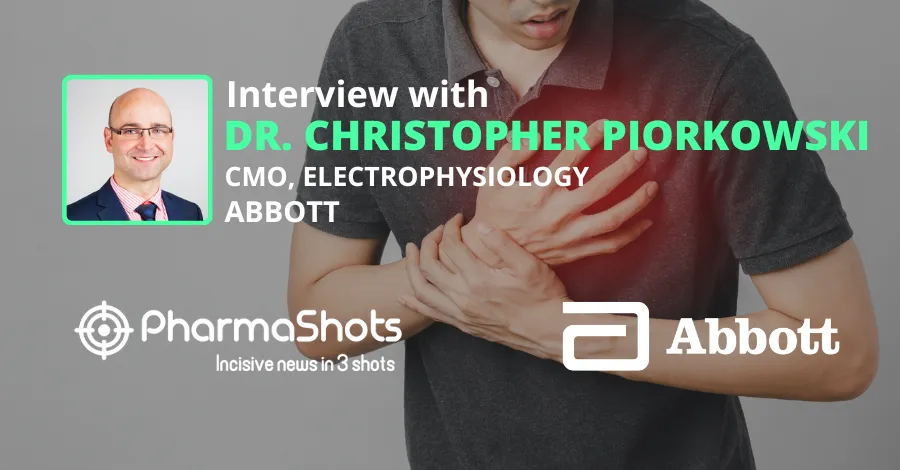Dr. Christopher Piorkowski Shares His Views on the US FDA Approval of TactiFlex Ablation Catheter to Treat Abnormal Heart Rhythm
Shots:
- Christopher started by highlighting the working of the TactiFlex Ablation Catheter and how it can be used for the treatment of patients with Atrial Fibrillation
- He also talked about the study design and the key findings from the TactiFlex AF IDE trial. He later gave a comparative view of the TactiFlex catheter vs. conventional ablation catheters
- The interview showcases Abbott’s developing portfolio of life-changing technologies in healthcare, with leading products in diagnostics, medical devices, nutritional and generic medicines
Smriti: To begin with, would you please highlight the functioning of the TactiFlex Ablation Catheter? How will this catheter prove to be a better treatment option for patients with Atrial Fibrillation (AFib)?
Dr. Christopher Piorkowski: We are proud to have recently earned U.S. FDA approval for Abbott’s TactiFlex Ablation Catheter, Sensor Enabled, the world’s first and only ablation catheter with the combination of a flexible tip with contact force technology.
TactiFlex is a game-changer for patients suffering from atrial fibrillation (AFib). With more than 37 million people worldwide living with AFib, it is the most common type of heart arrhythmia.
The TactiFlex catheter uses a flexible electrode tip with a laser-cut pattern that flexes when in contact with the heart wall. This unique design increases stability by up to two-times for consistent therapy delivery, meaning the catheter is more likely to stay in the desired location during radiofrequency (RF) delivery. In result, the catheter tip provides more and better tissue contact and it focuses the desired irrigation flow to the actual treated tissue.
When used with Abbott’s EnSite™ X EP System, physicians also have better three-dimensional catheter visualization providing a more precise and effective catheter placement. This can result in reduced procedure times and better safety for patients.
Smriti: Shed some light / insight on the study design along with the key findings of the study evaluating the effectiveness of the TactiFlex Ablation Catheter.
Dr. Christopher Piorkowski: The TactiFlex AF IDE trial was a non-randomized study of 355 patients enrolled at 37 sites worldwide. The purpose of the trial was to show the safety and effectiveness of the TactiFlex ablation catheter in the treatment of symptomatic atrial fibrillation that had not responded to previous drug therapies.
The findings showed the catheter created fast and safe lesions to treat AFib with over 99% acute procedural success and over 80% first pass pulmonary vein isolation using high-power ablation. Additionally, there was a reduction in procedure times, fluoroscopy times and administered irrigation fluid. These kind of trial findings are important because they give physicians strong insight into the performance of a catheter and help them assess how the catheter will support the care of their patients.
Smriti: Tell us more about how Abbott’s TactiFlex catheter and EnSite X EP System are designed to be synergistically used together.
Dr. Christopher Piorkowski: Abbott’s EnSite X EP System is our industry-leading cardiac mapping system. EnSite X helps physicians treat arrhythmias by accurately localizing the origin of the heart rhythm abnormality. Coupled with the enhanced localization capabilities of the new TactiFlex catheter, doctors can have a greater level of confidence that their intervention will be successful and deliver improved patient outcomes.
Smriti: Give our readers a comparative overview of the TactiFlex catheter vs. conventional ablation catheters used for the treatment of Atrial Fibrillation (AFib).
Dr. Christopher Piorkowski: The most significant difference is the unique flexible tip with contact force sensing. Until today, contact force technology has only been available for solid-tip catheters. TactiFlex truly is revolutionary because unlike other catheters on the market, TactiFlex uses a laser-cut design that flexes when in contact with the heart wall. This engineering feat of combining a soft tip with contact force is important to safety and effectiveness of the ablation – too little force and ablation is ineffective, too much force and ablation creates risks.
Combine TactiFlex with the EnSite X EP System and patients can feel more confident their procedure will deliver safe and effective results.
Smriti: Following the approval of TactiFlex catheter for Atrial Fibrillation (AFib), what are your commercialization strategies?
Dr. Christopher Piorkowski: In addition to U.S. FDA approval, the TactiFlex catheter is also commercially available in Europe, Japan, Africa and Australia and we see great feedback from those geographies as well.
Smriti: Are there any other products being developed under your product pipeline dedicated to the treatment of Atrial Fibrillation (AFib) or other indications?
Dr. Christopher Piorkowski: We’re excited about Abbott’s second generation of Pulse Field Ablation (PFA) that will be just one component of a complete portfolio of dedicated tools to treat arrhythmias in the future. PFA has the promise of improved safety, speed and ultimately efficacy. Abbott will continue to investigate that potential for the safe and efficient care for a variety of arrhythmias.
Abbott also recently launched the AFib LifeTM App that helps patients monitor their AFib and engage in an informed conversation with their physician. It helps patients better understand how AFib can impact their life and allows them to keep a journal to share with their physician.
The app also includes the first digital version of the widely used Atrial Fibrillation Effect on Quality of Life (AFEQT) questionnaire which the patient answers that provides a data point their physician uses to assess their AFib. It is easy to access and shareable with the patient’s physician for real-time updates.
Image source: Canva
About the Author:
Dr. Christopher Piorkowski

Dr. Christopher Piorkowski is the Chief Medical Officer of Abbott’s electrophysiology business. Dr. Piorkowski joined Abbott in 2020. Dr. Piorkowski has authored over 240 scientific publications with more than 4,500 citations. His clinical and scientific expertise covers the diagnosis and treatment of patients suffering from heart rhythm disorders. At Abbott, Dr. Piorkowski counsels the company on new approaches to helping patients battling complex cardiac arrhythmias like atrial fibrillation.
Related Post: Dr. Beth McQuiston Shares her Views on the US FDA Clearance of the First Concussion Blood Test Available for Lab Instruments



